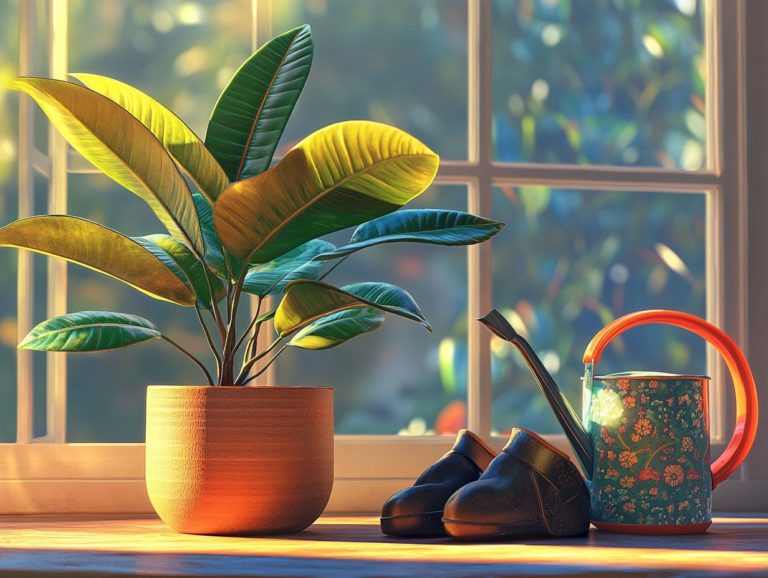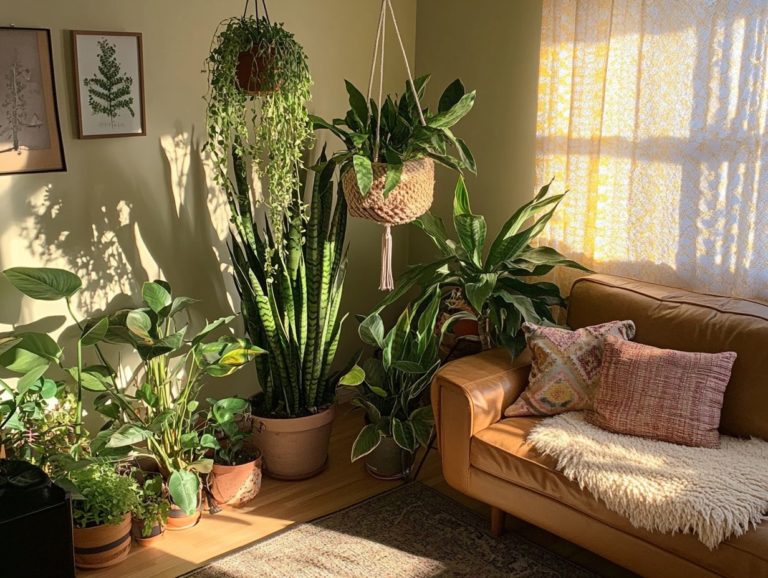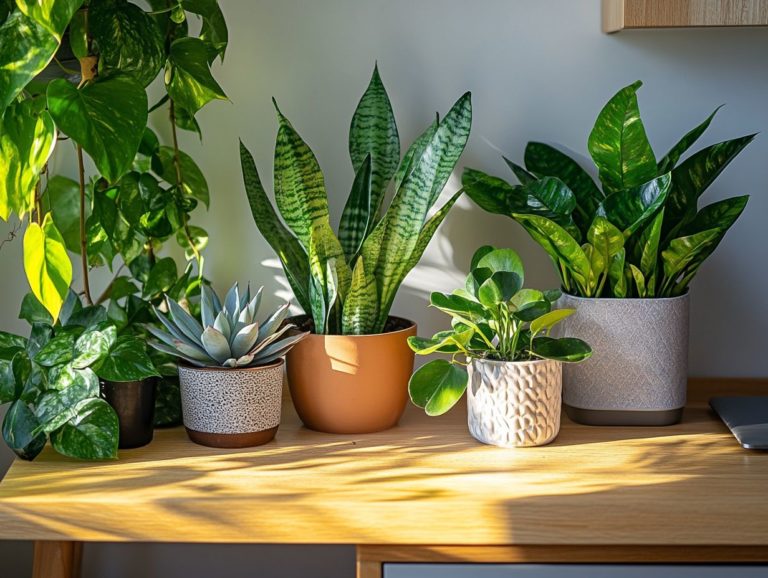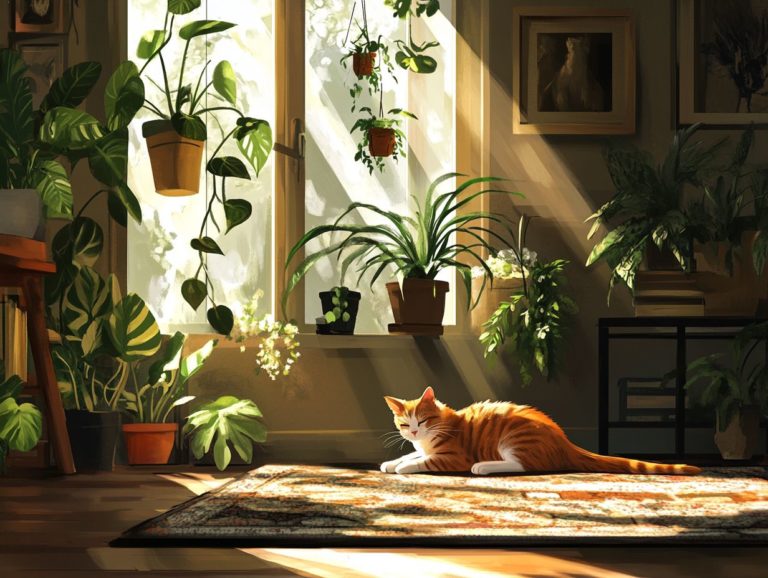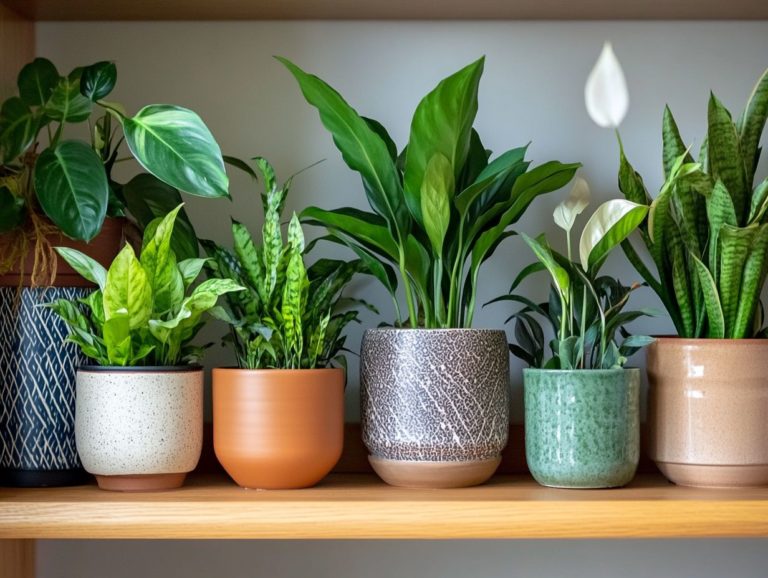Understanding the Care of Indoor Geraniums
Indoor geraniums infuse your home with vibrant color and life. They are a favorite among plant enthusiasts.
Get ready to discover the perfect geranium for your home! This guide will help you provide optimal light and temperature for their growth.
You ll quickly learn essential pruning and propagation methods to keep your plants thriving throughout the year.
Dive in and discover how to cultivate a flourishing indoor garden with these stunning blooms!
Contents
Key Takeaways:

- Choose the right geranium for your home by considering factors such as size, color, and type, including scented geraniums and ivy leaf geraniums.
- Provide optimal conditions for growth, including bright light and consistent temperatures.
- Maintain healthy geraniums by properly watering and feeding them, as well as pruning and propagating when necessary.
What are Indoor Geraniums?
Indoor geraniums, or Pelargoniums, are an excellent choice for you as a houseplant enthusiast. Their vibrant flower colors and straightforward care requirements make them appealing.
These resilient plants can thrive in various conditions, effortlessly adding life and color to your indoor spaces with minimal upkeep. Whether you’re a novice or a seasoned gardener, they make an ideal addition to your collection.
The allure of indoor geraniums goes beyond their stunning blossoms; they come in several fascinating varieties. Take Martha Washington geraniums, for instance, with their large, ruffled flowers and bold hues that demand attention.
Then there are scented geraniums, which release enchanting fragrances reminiscent of mint or lemon, offering a delightful sensory experience.
Ivy leaf geraniums deserve a mention too, as they’re particularly cherished for their trailing vines. They’re perfect for hanging baskets or displays on shelves, enhancing your indoor aesthetics while purifying the air (contributing to a healthier living environment).
Their adaptability allows them to flourish in a range of lighting conditions, effortlessly fitting into various indoor gardening styles.
Choosing the Right Geranium for Your Home
When you re choosing the perfect geranium for your home, it s crucial to explore various types, such as scented geraniums, ivy leaf geraniums, and Martha Washington geraniums.
Each of these varieties is particularly well-suited for container gardening and indoor care. With their unique characteristics, these geraniums not only enhance your indoor environment but also thrive beautifully in your specific living conditions. For those interested in similar plants, understanding the care of indoor hibiscus can also offer great insights.
Factors to Consider for Indoor Growth
Several crucial factors will elevate your indoor geraniums to new heights, including their light requirements, temperature preferences, the ideal potting mix, and proper watering techniques.
Light is paramount; geraniums thrive in bright, indirect sunlight. Positioning them near a window that bathes them in ample light will encourage vibrant blooms.
Temperature is another key player. These plants prefer a warm environment, ideally between 65 F and 75 F. Keeping them away from drafts or extreme heat sources will greatly benefit their health.
Opt for a well-draining potting mix enriched with organic matter. This provides the essential nutrients while preventing root rot (a condition that causes plant roots to decay).
Establishing a consistent watering routine is essential. Allow the top inch of soil to dry between watering sessions to maintain the health of your plants.
By implementing these actionable tips, you’ll create an optimal environment for thriving indoor geraniums.
Light and Temperature Requirements
The light and temperature requirements for geraniums are crucial for fostering their healthy growth. These plants flourish in bright, indirect sunlight and thrive best in temperatures between 65 F and 75 F.
By skillfully managing these conditions, you can enjoy vibrant blooms and lush foliage, significantly enhancing the beauty of your indoor garden.
Start cultivating your indoor geraniums today and watch your space come alive!
Optimal Conditions for Growth
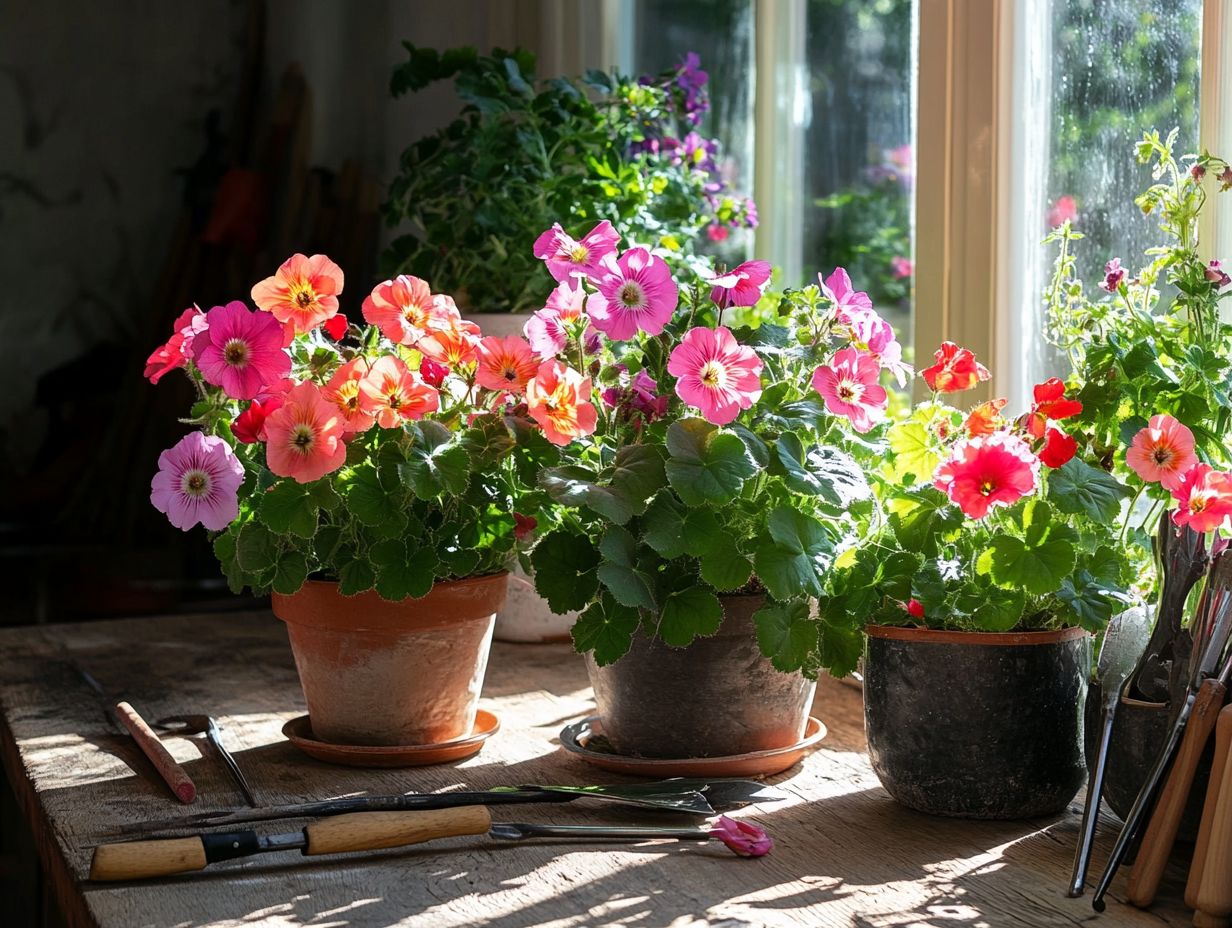
To create the perfect conditions for geranium growth, ensure you have well-drained soil, adequate light, and the right temperature. These elements work together to create an environment where your geraniums can thrive and display their stunning blooms indoors.
Start with well-drained soil ideally a mix that includes perlite or sand. This prevents root rot and promotes healthy air circulation. Position your geraniums near a south-facing window to provide the 6-8 hours of bright, indirect sunlight they crave for robust growth.
Keep indoor temperatures between 65 F and 75 F. Dropping too low can hinder their flowering potential.
Think of a sunny windowsill or a greenhouse as ideal indoor settings to achieve these conditions, ensuring your plants flourish beautifully, even in tighter spaces.
Watering and Feeding Techniques
Effective watering and feeding techniques are essential for maintaining the health of your geraniums. Overwatering can lead to root rot, while underwatering may stress the plant.
By establishing a balanced watering schedule and choosing the right fertilizer, you can ensure your geraniums receive the nutrients they need to flourish indoors. Additionally, for those interested in caring for other plants, understanding the care of indoor palms can enhance your indoor gardening experience.
Proper Care for Healthy Geraniums
Taking care of your geraniums can be fun and rewarding! It requires a complete method that includes watering, fertilizing, and pest control. By understanding the specific needs of geraniums, you can create an ideal indoor environment for these stunning houseplants.
Start by considering the variety you have. For instance, zonal geraniums prefer to dry out a bit between waterings, while ivy geraniums enjoy a little more moisture.
Establish a consistent fertilization schedule during the growing months. Aim to use a balanced liquid fertilizer every 4-6 weeks to promote lush foliage and abundant blooms.
Regularly inspect the leaves for signs of healthy growth like bright green leaves and robust flowers. Stay vigilant for pests such as aphids or spider mites to prevent future infestations.
If issues arise, using suitable insecticidal soap can effectively tackle these problems while keeping your plants unharmed.
Pruning and Propagation
Pruning and propagation are vital practices for maintaining the health and vitality of your geraniums. Regular pruning encourages bushier growth, creating a fuller, more vibrant plant.
Effective propagation methods allow you to multiply your collection, expanding your garden s beauty. By mastering these techniques, you can ensure a continuous supply of stunning blooms and lush foliage, elevating your indoor garden to new heights.
How to Maintain and Multiply Your Geraniums
To maintain and multiply your geraniums effectively, embrace regular pruning and efficient propagation methods. These strategies will elevate your indoor gardening experience and enhance the health of your existing plants.
Pruning should ideally occur in early spring. Trim back leggy growth and remove dead leaves to encourage a bushier, more vibrant appearance.
For propagation, stem cuttings are a favored technique that makes creating new plants easy. Take a healthy cutting, let it dry for a few hours, and then nestle it into moist soil.
After propagation, provide the new plants with bright, indirect light and ensure consistent moisture. This care helps them acclimate and thrive, leading to lush, vigorous geraniums that will brighten any space you choose.
Common Pests and Diseases
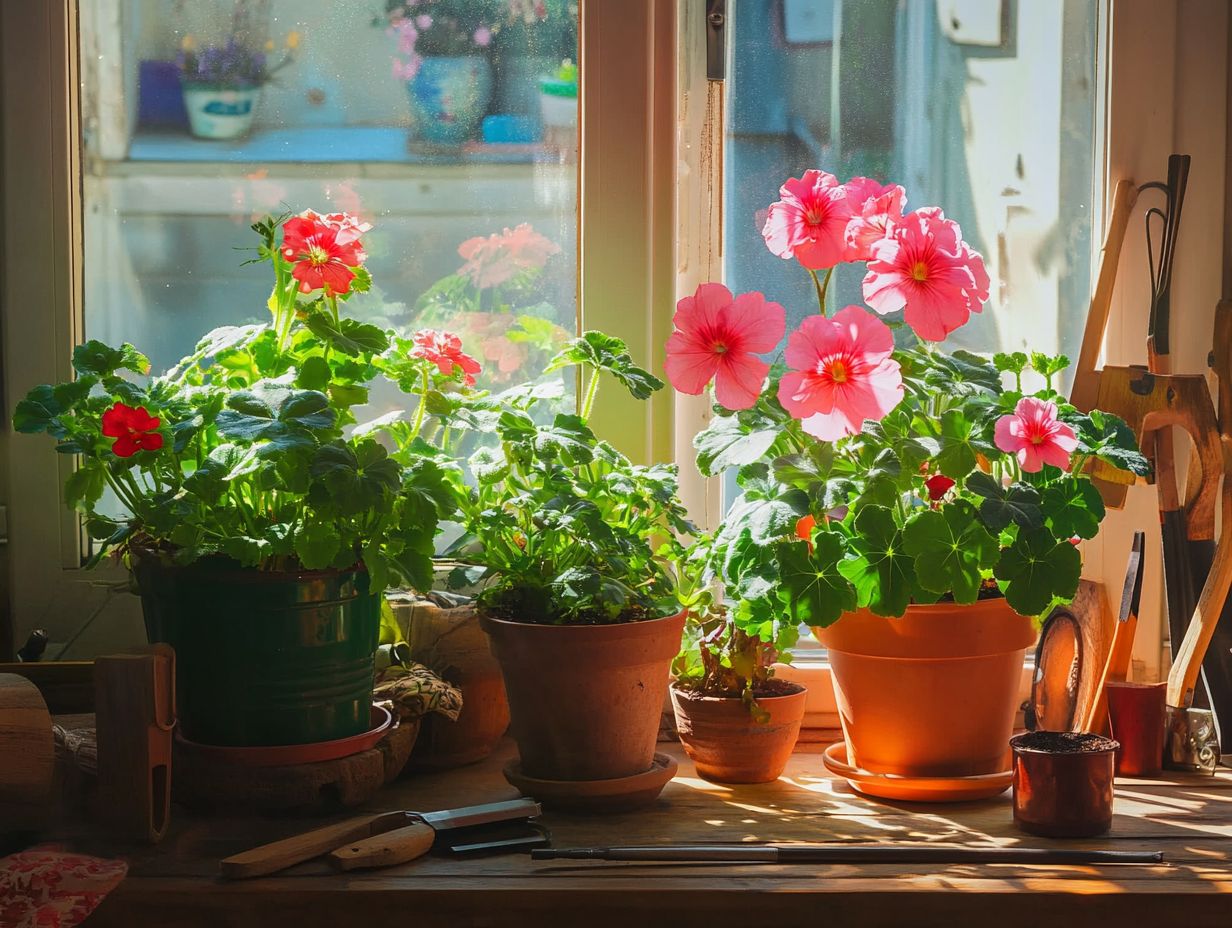
Identifying and managing common pests and diseases is essential for the health of your geraniums. These lovely plants can fall victim to issues like fungus gnats and aphids, which may impede their growth and vitality.
Using effective pest control methods helps ensure that your indoor geraniums remain lush and vibrant, thriving in their full glory.
Identifying and Treating Issues
Recognizing the telltale signs of stress or infestations is the first step to addressing issues with your geraniums. Look for symptoms like yellowing leaves or stunted growth, which might indicate problems such as fungus gnats or nutrient deficiencies.
Nutrient deficiencies occur when plants lack essential nutrients, leading to poor health. Timely diagnosis and treatment are crucial for maintaining the well-being of your indoor geraniums.
Observe your plants closely for any changes in texture, color, or overall vigor. Checking the soil moisture levels can help determine if overwatering or underwatering is affecting your plants health.
Once you spot any issues, research potential causes. For example, brown leaf edges could indicate underwatering or low humidity, while a powdery residue might suggest a pest issue nearby.
You should amend the soil as needed for proper treatment, adjust your watering schedule, or apply targeted pesticides. Preventative care is important, as it fosters a healthy environment and establishes a consistent maintenance routine.
Winter Care for Indoor Geraniums
Winter care is vital! Keep your geraniums thriving during the colder months with the right steps, especially as temperatures drop and daylight hours dwindle.
By mastering the art of overwintering geraniums, you can ensure these stunning houseplants not only survive but thrive in your home.
Preparing for Cold Weather
Preparing for cold weather is essential for successfully overwintering your geraniums. Adapt their care routine to suit lower temperatures and reduced light.
Start by gradually reducing watering geraniums as temperatures drop. Allow the soil to dry out a bit between sessions to prevent root rot and help your geraniums conserve energy.
With daylight hours dwindling, consider investing in grow lights to provide the extra illumination they need to flourish indoors. Position them thoughtfully, away from drafty windows or heat sources.
Maintaining a consistent humidity level during the colder months can also work wonders. Misting the leaves occasionally or using a humidity tray can promote healthy growth, giving your geraniums the best chance to thrive until spring arrives. This is particularly important for scented geraniums and ivy leaf geraniums. Additionally, if you’re interested in expanding your indoor plant collection, consider understanding the care of indoor zinnias, which can also flourish in similar environments.
Frequently Asked Questions
What are some basic care tips for indoor geraniums?
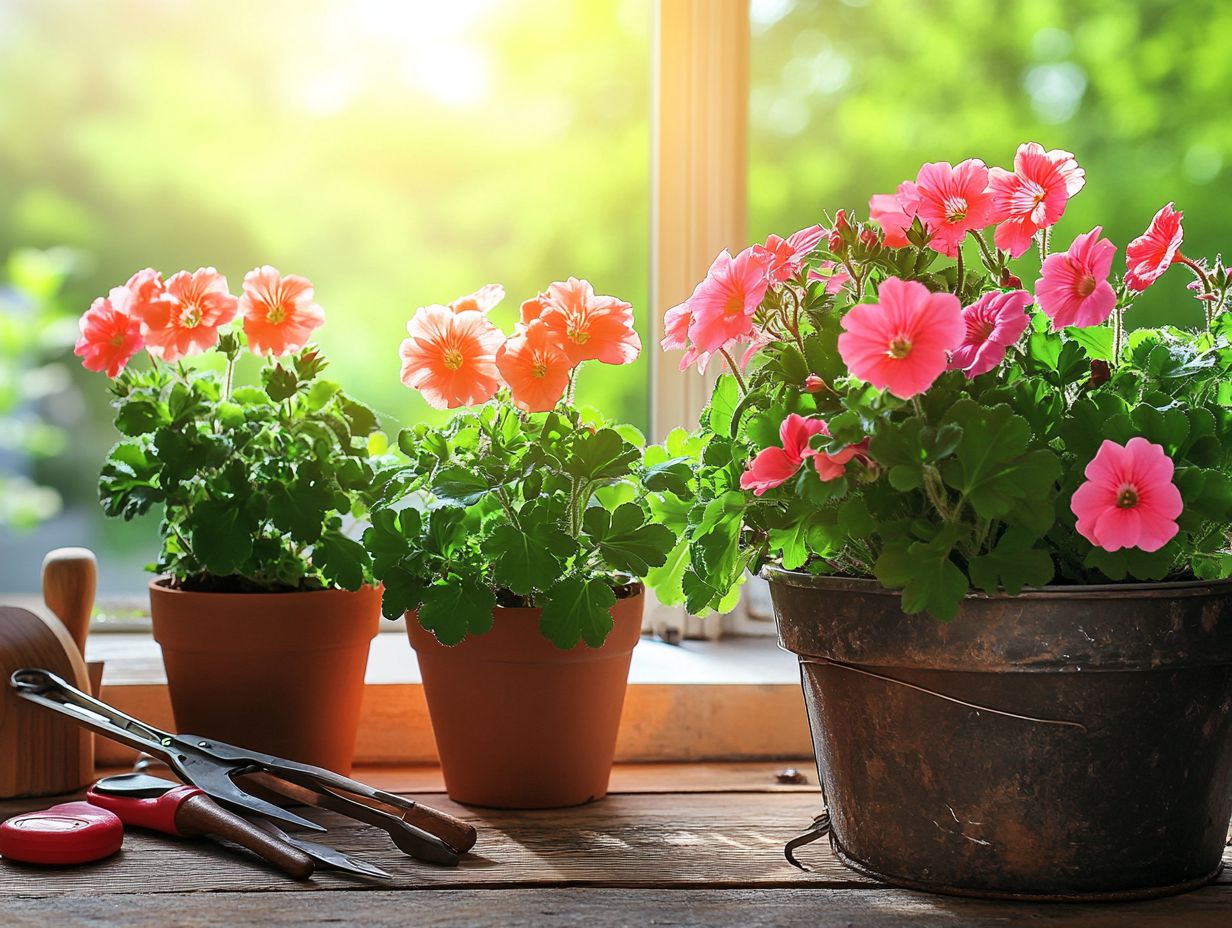
Indoor geraniums require bright, indirect sunlight and well-draining potting soil. Water them regularly, ensuring the soil does not dry out completely between waterings.
How often should I water my indoor geraniums?
Water your indoor geraniums when the top inch of soil feels dry to the touch. This may vary depending on the temperature and humidity levels in your home, but on average, they should be watered 1-2 times per week.
Do indoor geraniums need fertilizer?
Yes, indoor geraniums benefit from regular fertilizing indoors. Use a balanced fertilizer once a month during the growing season to promote healthy growth and blooming indoors.
Should I prune my indoor geraniums?
Yes, regular pruning is important for maintaining the shape and health of indoor geraniums. Remove any dead or yellowing leaves, as well as spent flowers, to encourage new growth and blooming.
Get started today and watch your geraniums thrive!
Can I grow my indoor geraniums?
Yes! You can easily grow indoor geraniums from stem cuttings. Just take a 3-4 inch cutting from a healthy stem, remove the bottom leaves, and place the cutting in water or potting soil.
What are the signs of unhealthy indoor geraniums?
Watch for wilting, yellowing leaves, and no blooms. Check for pests quickly! Ensure your plant gets enough sunlight and water for a healthy life!


